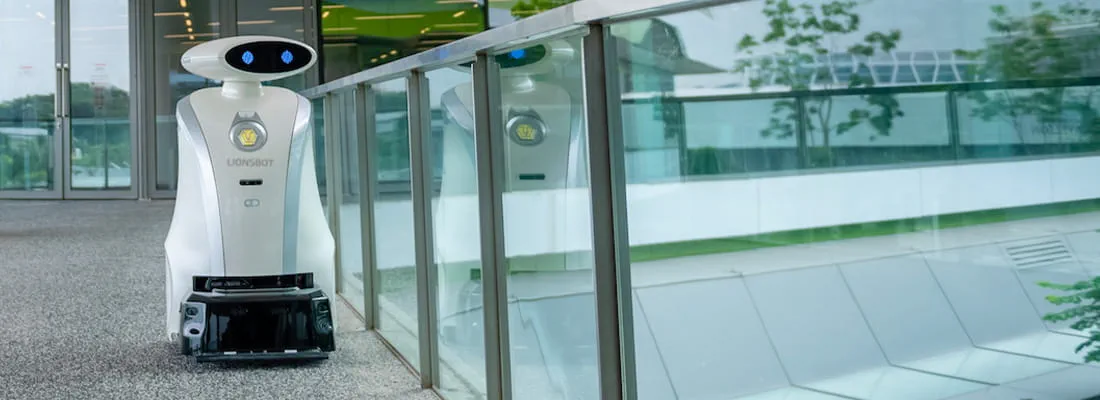You may have heard of robotics, but the latest innovation trend in automated cleaning is powered by cobotics. These robot cleaners harness the power of technology, but there is a collaborative element to these machines. Within the world of cobotics, robot and human work together to get the job done in the most efficient way possible. These technological wizards work alongside people, not in their place.
Cobots can perform work in close collaboration with a cleaning team and automate a large range of tasks. So how do they work? A cobot can be given instructions by a human to do the specific job required. Once programmed the machine can then work autonomously on a task, but also in harmony with a person or persons. Cobotic technology can be used to clean commercial office spaces as well as hospitals, supermarkets, warehouses, showrooms, shopping centres, halls and public facilities.
Cobots could be set to revolutionise the cleaning industry sector, helping companies increase their productivity through the use of modern collaborative robots. Dave Holmes, Manufacturing Director of BAE Systems, said in a recent article in The Telegraph that “understanding how to blend new technology with current skills of the workforce is essential.”
But will humans have the vision and ability to implement this technology and adopt these robots into their cleaning routines? It can be argued, in the world of cleaning, that the human hand can simply do a better job. However, cobots could be used to provide greater strength and resilience in some tasks. They may also be able to reach awkward areas of buildings and public spaces that humans cannot easily access.
Cobotics is still an emerging field of technology. We may be entering the era of humans and robots working in harmony, but what specific type of collaborative robots can be used to make the cleaning industry more streamlined and efficient?
One cobotics manufacturer called ICE Co-botics, aim to help businesses improve the wellbeing and hygiene of a space. They have “a proven track record in being committed and invested in autonomous cleaning.” Their Eco Bot 50 automated floor cleaner, produced by Gaussian Robotics, has several functions. It is a scrubber dryer and takes just 30 minutes to map a 2000m square area. Over 20 sensors allow it to perceive the environment, avoid obstacles and prevent collisions.
One of the main benefits of the Eco Bot 50 is its autonomy. It cleans on schedule, requiring no human intervention in its cleaning operations. The machine will also automatically return to the charging point when the battery is low. However, the human element is still part of the process. Operators can monitor performance and access cleaning reports through an interactive fleet management system.
Another great example of a manufacturer of innovative cobots is the winner of the Amsterdam Innovation Award 2020. The Leobot by Lionsbot was voted as the overall winner, because this family of floor cleaning robots are capable of performing a wide range of tasks. This socialised robot is able to build a relationship with human cleaners through continuous interaction with the environment. By doing this the Leobot cobot elevates the cleaner’s status and motivation, helping them take pride in their job. This robot brings cleaning out into the public domain in a fun and positive way.
BICSc, the largest independent, professional and educational body within the cleaning industry, has done some research into the field entitled ‘Cobotic Evolution in Cleaning’. The have found that leaders within the facilities management sector “recognise the potential for cobotics to improve overall performance within their operations and deliver commercial efficiencies.”
These machines may be particularly relevant in the times of a global pandemic. Covid-19 has proved that a heavy reliance upon having people working on site is not practical. This applies to cleaners as well as office workers. Where significant numbers of cleaners have been off sick or needed to self-isolate, resourcing has been a huge challenge in these times.
This is where cobots could step in. Although cleaning will always be reliant on the skills of people, deploying cobots to do some of the mundane and time consuming jobs could free up staff that are still available – and crucially prevent the need for there to be too many staff on site.
On the other side of the argument, one potential barrier in the adoption of cobots may be that workers feel they could be replaced by robots. It seems that the key to encouraging the adoption of cobots is to recognise the strength of both the human worker and the robotic worker, using the best elements of both to achieve a combined solution.
According to the BICSc report, “Facilities Management leaders are aware of the need to re-invent their resourcing and commercial models going forward, to take advantage of the relative strengths of both people and machines by forging a hybrid workforce.”
Therefore, a key priority in paving the way for cobotics to become an everyday part of our lives is to acknowledge the collaborative benefits of using both human labour and technology. We can harness the power of both and think about how to cleverly combine the two.
In this increasingly collaborative world, where humans rely more heavily on machines, it is not hard to imagine a future where robot and employee work in unison to achieve better results. The global commercial cleaning industry seems a great place to start this cobotic revolution!
Interclean is an International commercial cleaning trade show that makes innovation easily accessible to everybody. The latest developments in cleaning technology, including cobotics, will be showcased at the RAI, Amsterdam from 10-13 May 2022.






